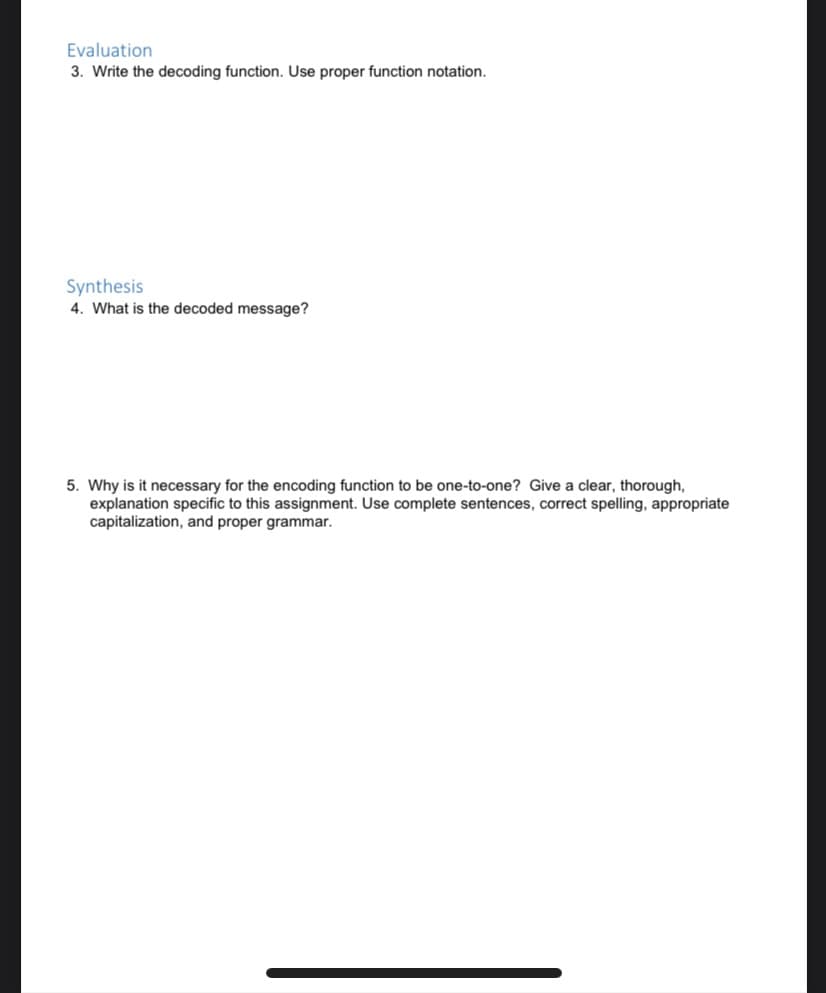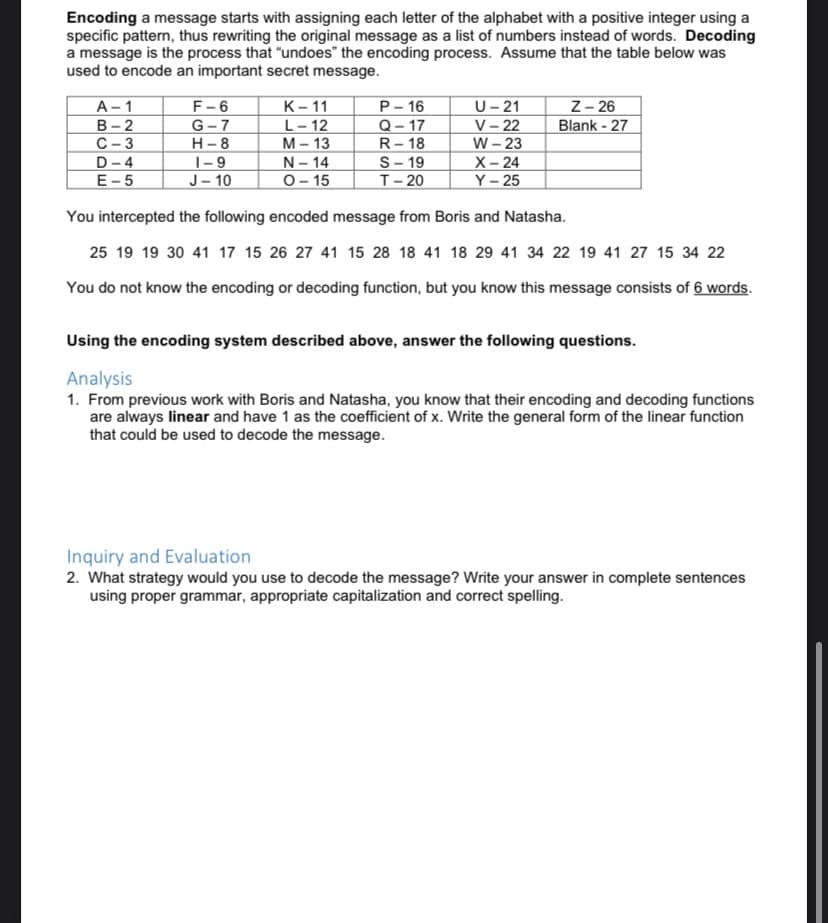Encoding a message starts with assigning each letter of the alphabet with a positive integer using a specific pattern, thus rewriting the original message as a list of numbers instead of words. Decoding a message is the process that "undoes" the encoding process. Assume that the table below was used to encode an important secret message. Z- 26 Blank - 27 U- 21 V- 22 W- 23 X- 24 Y-25 A - 1 F-6 К-11 P- 16 L- 12 М-13 В -2 G-7 Н-8 С -3 D- 4 E-5 N- 14 O- 15 Q-17 R- 18 S- 19 т- 20 1-9 J- 10 You intercepted the following encoded message from Boris and Natasha. 25 19 19 30 41 17 15 26 27 41 15 28 18 41 18 29 41 34 22 19 41 27 15 34 22 You do not know the encoding or decoding function, but you know this message consists of 6 words. Using the encoding system described above, answer the following questions. Analysis 1. From previous work with Boris and Natasha, you know that their encoding and decoding functions are always linear and have 1 as the coefficient of x. Write the general form of the linear function that could be used to decode the message. Inquiry and Evaluation 2. What strategy would you use to decode the message? Write your answer in complete sentences using proper grammar, appropriate capitalization and correct spelling.
Encoding a message starts with assigning each letter of the alphabet with a positive integer using a specific pattern, thus rewriting the original message as a list of numbers instead of words. Decoding a message is the process that "undoes" the encoding process. Assume that the table below was used to encode an important secret message. Z- 26 Blank - 27 U- 21 V- 22 W- 23 X- 24 Y-25 A - 1 F-6 К-11 P- 16 L- 12 М-13 В -2 G-7 Н-8 С -3 D- 4 E-5 N- 14 O- 15 Q-17 R- 18 S- 19 т- 20 1-9 J- 10 You intercepted the following encoded message from Boris and Natasha. 25 19 19 30 41 17 15 26 27 41 15 28 18 41 18 29 41 34 22 19 41 27 15 34 22 You do not know the encoding or decoding function, but you know this message consists of 6 words. Using the encoding system described above, answer the following questions. Analysis 1. From previous work with Boris and Natasha, you know that their encoding and decoding functions are always linear and have 1 as the coefficient of x. Write the general form of the linear function that could be used to decode the message. Inquiry and Evaluation 2. What strategy would you use to decode the message? Write your answer in complete sentences using proper grammar, appropriate capitalization and correct spelling.
Database System Concepts
7th Edition
ISBN:9780078022159
Author:Abraham Silberschatz Professor, Henry F. Korth, S. Sudarshan
Publisher:Abraham Silberschatz Professor, Henry F. Korth, S. Sudarshan
Chapter1: Introduction
Section: Chapter Questions
Problem 1PE
Related questions
Question

Transcribed Image Text:Evaluation
3. Write the decoding function. Use proper function notation.
Synthesis
4. What is the decoded message?
5. Why is it necessary for the encoding function to be one-to-one? Give a clear, thorough,
explanation specific to this assignment. Use complete sentences, correct spelling, appropriate
capitalization, and proper grammar.

Transcribed Image Text:Encoding a message starts with assigning each letter of the alphabet with a positive integer using a
specific pattern, thus rewriting the original message as a list of numbers instead of words. Decoding
a message is the process that "undoes" the encoding process. Assume that the table below was
used to encode an important secret message.
F-6
G- 7
Z- 26
Blank - 27
P- 16
U- 21
V– 22
W- 23
х-24
Y- 25
А-1
К-11
В -2
С -3
D- 4
E-5
Q- 17
R- 18
H-8
|- 9
J- 10
L- 12
М-13
N- 14
о- 15
S- 19
т- 20
You intercepted the following encoded message from Boris and Natasha.
25 19 19 30 41 17 15 26 27 41 15 28 18 41 18 29 41 34 22 19 41 27 15 34 22
You do not know the encoding or decoding function, but you know this message consists of 6 words.
Using the encoding system described above, answer the following questions.
Analysis
1. From previous work with Boris and Natasha, you know that their encoding and decoding functions
are always linear and have 1 as the coefficient of x. Write the general form of the linear function
that could be used to decode the message.
Inquiry and Evaluation
2. What strategy would you use to decode the message? Write your answer in complete sentences
using proper grammar, appropriate capitalization and correct spelling.
Expert Solution
This question has been solved!
Explore an expertly crafted, step-by-step solution for a thorough understanding of key concepts.
This is a popular solution!
Trending now
This is a popular solution!
Step by step
Solved in 5 steps with 2 images

Knowledge Booster
Learn more about
Need a deep-dive on the concept behind this application? Look no further. Learn more about this topic, computer-science and related others by exploring similar questions and additional content below.Recommended textbooks for you

Database System Concepts
Computer Science
ISBN:
9780078022159
Author:
Abraham Silberschatz Professor, Henry F. Korth, S. Sudarshan
Publisher:
McGraw-Hill Education

Starting Out with Python (4th Edition)
Computer Science
ISBN:
9780134444321
Author:
Tony Gaddis
Publisher:
PEARSON

Digital Fundamentals (11th Edition)
Computer Science
ISBN:
9780132737968
Author:
Thomas L. Floyd
Publisher:
PEARSON

Database System Concepts
Computer Science
ISBN:
9780078022159
Author:
Abraham Silberschatz Professor, Henry F. Korth, S. Sudarshan
Publisher:
McGraw-Hill Education

Starting Out with Python (4th Edition)
Computer Science
ISBN:
9780134444321
Author:
Tony Gaddis
Publisher:
PEARSON

Digital Fundamentals (11th Edition)
Computer Science
ISBN:
9780132737968
Author:
Thomas L. Floyd
Publisher:
PEARSON

C How to Program (8th Edition)
Computer Science
ISBN:
9780133976892
Author:
Paul J. Deitel, Harvey Deitel
Publisher:
PEARSON

Database Systems: Design, Implementation, & Manag…
Computer Science
ISBN:
9781337627900
Author:
Carlos Coronel, Steven Morris
Publisher:
Cengage Learning

Programmable Logic Controllers
Computer Science
ISBN:
9780073373843
Author:
Frank D. Petruzella
Publisher:
McGraw-Hill Education